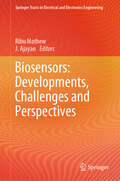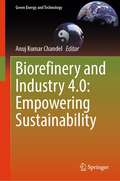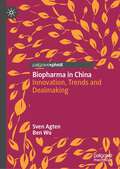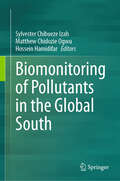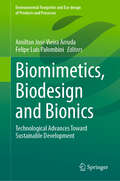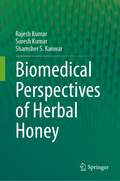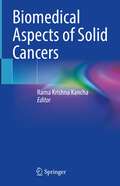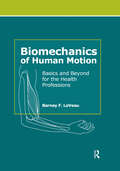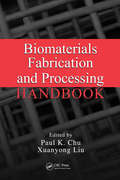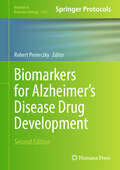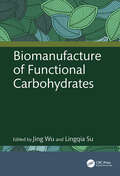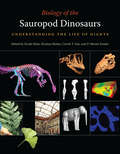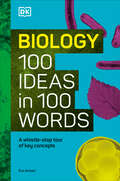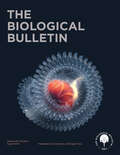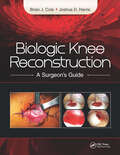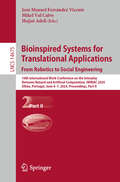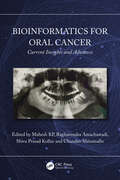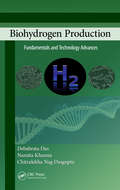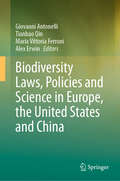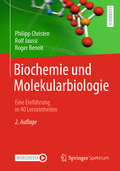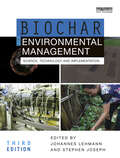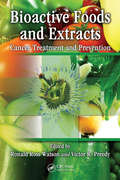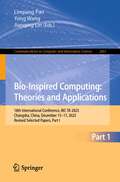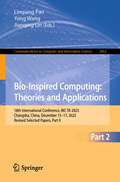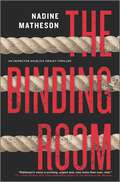- Table View
- List View
Biosensors: Developments, Challenges and Perspectives (Springer Tracts in Electrical and Electronics Engineering)
by J. Ajayan Ribu MathewThis book equips its readers with fundamental concepts and a comprehensive understanding of the principle and functionality of biosensors. This book focuses on various biosensor technologies like field effect transistor (FET), plasmonics, bioresorbable biosensors, electro-chemical biosensors, etc., and their applications. The book also covers the reliability aspects and challenges in biosensor development that are a major cause of erroneous calibration and even failure. The book also features the concept of bio receptors, immobilization techniques, target-receptor interactions, surface energy changes, sensitivity, selectivity, etc. This would be an ideal reference for researchers and scholars studying biosensors realized with various material sets and technologies including state-of-the-art modern materials and innovative techniques.
Biorefinery and Industry 4.0: Empowering Sustainability (Green Energy and Technology)
by Anuj Kumar ChandelThis book provides a comprehensive overview of the latest advances in the production of low carbon chemicals and biofuels from renewable feedstock, including pilot, demo, and commercial-scale technologies. It highlights the role of Industry 4.0 in improving the efficiency and affordability of biorefineries, ultimately leading to the production of bio-based molecules and energy with low carbon and water footprints. Drawing on the expertise of established researchers, academics, and engineers, the book presents a range of informative chapters on the subject. It explores the key elements of Industry 4.0, such as, interconnectivity and smart process automation, and shows how these can be harnessed to revolutionize industrial processes and offer finished products in a cost-effective manner. With its emphasis on sustainability and cutting-edge technology, this book is an essential resource for anyone interested in the future of low carbon chemistry and bioenergy production.
Biopharma in China: Innovation, Trends and Dealmaking
by Sven Agten Ben WuThis book provides an insider’s overview of the emerging Chinese biopharma sector, its dynamics and trends, first bust and boom cycle, long-term perspectives, and how as a foreign company or investor to tap into this. China has gone from a country with no innovation in drug discovery, to a country which starts to out-license its biopharma technology to the rest of the world. The Chinese biopharma sector is only a decade old, but it already has become a new driver of growth and value. The book takes a closer look at what drives Chinese innovation in the biopharma sector, how to deal with this innovation, and what opportunities and challenges this provides for foreign companies. The book also takes a deep dive into its first biopharma boom and bust cycle, and what it means for the sector. It also explains what deals Chinese biopharma companies and investors are looking for, what works and what doesn’t, and how as a foreign company can tap into the world’s second largest healthcare market.
Biomonitoring of Pollutants in the Global South
by Sylvester Chibueze Izah Matthew Chidozie Ogwu Hossein HamidifarThe edited book serves as a reference on indicators of environmental pollution and how to sustainably ascertain the effects of different pollutants on life forms. It addresses an improved technology for monitoring contaminants, especially in the Global South and beyond, where the level of technology available for sustainable management of environmental quality is limited. Biomonitoring ecosystems' health by using organisms to gather quantitative data on environmental quality is one of the most straightforward and affordable ways to check environmental quality. Since organisms may function as environmental sensors, their use in the direct measurement of environmental quality in the process of biomonitoring studies implicates the health status of various ecosystems. In this regard, microorganisms, higher and lower plants, invertebrates, and vertebrate animals are beneficial since they can detect pollution levels and pollutants in the environment. This book is of interest and useful to toxicologists, water, soil, and air quality experts, practitioners, trainees, and trainers, biological sciences scientists, academicians, researchers, students (especially undergraduates and postgraduates), libraries, and other public knowledge repositories interested in novel and advanced practices in sustainable biomonitoring of environmental pollutants.
Biomimetics, Biodesign and Bionics: Technological Advances Toward Sustainable Development (Environmental Footprints and Eco-design of Products and Processes)
by Felipe Luis Palombini Amilton José Vieira ArrudaNature is a vast source of inspiration and information for the resolution of complex problems and can influence many varieties of design. Biomimetics, biodesign and bionics are three branches of interdisciplinary research merging biological and applied sciences. This volume collects cases that highlight recent breakthroughs in these disciplines. Biological features such as patterns, shapes, mechanisms, colors, structures, and more can be analyzed, organized, and modeled for application in human creations. Therefore, design, engineering, and architecture projects can benefit from solutions that were already tested and verified through evolution in the natural world. With the development of new technologies for the investigation, simulation, and testing of natural features, the path from nature to product can be accelerated. The cases presented in this work showcase how technological advancements are leading to improved design solutions and influencing our very comprehension of natureand its complex organization.
Biomedical Perspectives of Herbal Honey
by Rajesh Kumar Suresh Kumar Shamsher S KanwarThis book overviews honey and herbs that profoundly affect human metabolism when mixed in a balanced ratio. It covers various aspects of honey added to herbs and provides collective information and practical approaches regarding herbal honey and its applications as functional food and medicine. Honey has miraculous properties like anti-bacterial, anti-fungal, free radical scavenging, and anti-carcinogenic, so honey has tremendous therapeutic importance. Infusion of extract from various medicinal herbs in honey further modulates its therapeutic potential. This book provides all the information about the essentials of herbs-infused honey and its efficiency in fighting against pathogenic bacteria. It presents the significance and benefits of honey infused with herbs that may promote/boost immunity to fight contagious or non-contagious diseases. Not only does this book explain the comprehensive knowledge of herbal honey and its medicinal properties based on current researched evidence, but it also explores the contribution of herbal honey in the food science and medicine industry as a significant part of nutraceuticals and functional food research. By providing knowledge about the formulation of traditionally used herbs in combination with honey, scientific knowledge can be supplied and made available to the common public which shall probably be a real contribution to society.
Biomedical Aspects of Solid Cancers
by Rama Krishna KanchaThis book offers an overview of the biological basis of 26 different solid cancers for scientists and oncologists to understand the clinical challenges. The book provides a quick, simplified, and updated review of the present genetic or genomic medicine era. With genetic and molecular details to enhance understanding of biological mechanisms underlying disease pathogenesis and treatment response, each chapter covers epidemiology, risk factors, classification, pathophysiology, genetics, and treatment of solid cancers.This book is a beginner’s guide for life sciences and medicine graduate students, fellows in training, biomedical sciences researchers, principal investigators, clinician-researchers and oncologists.
Biomechanics of Human Motion: Basics and Beyond for the Health Professions
by Barney LeVeauBiomechanics of Human Motion: Basics and Beyond for the Health Professions presents a straightforward approach to the basic principles, theories and applications of biomechanics and provides numerous techniques and examples for approaching biomechanical situations enhanced by healthcare professionals.Building on his previous work, Dr. Barney LeVeau uses clearly defined, concise terms and real-life applications rather than advanced mathematics to make teaching and learning biomechanics easier. Based upon the concept of force, the text illustrates how force is applied to the human body and how the body applies force to various objects. The emphasis is upon the pertinent factors that guide the reader to an understanding of biomechanics at a beginning level.Chapter Topics Include:• Strength of material such as loading and stress-strain relationships• Composition and Resolution of Forces such as graphic method and mathematical method• Equilibrium such as static, first condition and second condition• Dynamics such as kinematics and kinetics • Application such as stability and balance, motion analysis, and gaitWhat’s Inside:• Simple explanations of biological & mechanical concepts• Contemporary articles at the end of each chapter providing readers with information beyond the basics• Over 240 images illustrate biomechanical situations and computations• User-friendly, uncomplicated mathematical formulas and examplesBiomechanics of Human Motion: Basics and Beyond for the Health Professions provides students and clinicians of all allied health professions with a basic background and solid foundation on which to build a solid understanding of force and biomechanics.
Biomaterials Fabrication and Processing Handbook
by Paul K. Chu Xuanyong LiuFocusing on a lucrative and increasingly important area of biomedicine, the Biomaterials Fabrication and Processing Handbook brings together various biomaterials production and processing aspects, including tissue engineering scaffold materials, drug delivery systems, nanobiomaterials, and biosensors. With contributions from renowned interna
Biomarkers for Alzheimer’s Disease Drug Development (Methods in Molecular Biology #2785)
by Robert PerneczkyThis fully updated volume provides an up-to-date and comprehensive overview of the current state of technologies helping to accelerate Alzheimer’s disease drug development. Addressing the latest advances in preclinical and clinical research, including new insights into the molecular mechanisms and emerging therapeutic strategies, the book continues by exploring digital biomarkers and advanced neuroimaging analysis which will transform how clinical trials in the Alzheimer’s disease field are performed. Written for the highly successful Methods in Molecular Biology series, chapters feature the kind of detailed implementation advice that leads to greater success in the lab or clinic. Authoritative and practical, Biomarkers for Alzheimer’s Disease Drug Development, Second Edition seeks to inspire and inform future efforts to develop effective treatments for this devastating disease.
Biomanufacture of Functional Carbohydrates
by Jing Wu and Lingqia SuFunctional carbohydrates have low or moderate energy and health-promoting effects. They are greatly favored in a variety of areas, such as food, pharmaceuticals, feed, and agriculture. The low-cost and high-yield manufacturing of functional carbohydrates is a prerequisite for their widespread application. Compared to extraction and chemical methods, biomanufacture dominates the production of functional carbohydrates, and there have been continuous innovations and technological progress over the last decades.Biomanufacture of Functional Carbohydrates provides the systemic introduction of biomanufacture of ten functional carbohydrates. Each chapter introduces the function and application of a functional carbohydrate, and then focuses on the recent advancements of the enzymes and catalytic pathways associated with its biosynthesis. It provides detailed information on the structure and function, molecular modification, and preparation of the relative enzymes and the strategies of preparation of the functional carbohydrates catalyzed by single or complex enzymes and discusses the characteristics of different strategies. The microbial fermentation methods for producing some functional carbohydrates, including details about construction and regulation of recombinant strains, are also described. In addition, this book provides suggestions for future research in the biomanufacture of functional carbohydrates.Features: Presents detailed information of enzymes used for preparation of the functional carbohydrates Focuses on the structure and function, molecular modification, and preparation of the relative enzymes Introduces strategies of preparation of the functional carbohydrates catalyzed by single or complex enzymes Compares the characteristics of different strategies Readers will gain timely and comprehensive knowledge of the emerging science and technology around biomanufacture of functional carbohydrates and how to select, acquire, and use the appropriate enzymes to produce functional carbohydrates and advance the benefits of human life.
Biology of the Sauropod Dinosaurs: Understanding the Life of Giants (Life of the Past)
by Nicole Klein, Kristian Remes, Carole T. Gee and P. Martin SanderSauropods, those huge plant-eating dinosaurs, possessed bodies that seem to defy every natural law. What were these creatures like as living animals and how could they reach such uniquely gigantic sizes? A dedicated group of researchers in Germany in disciplines ranging from engineering and materials science to animal nutrition and paleontology went in search of the answers to these questions. Biology of the Sauropod Dinosaurs reports on the latest results from this seemingly disparate group of research fields and integrates them into a coherent theory regarding sauropod gigantism. Covering nutrition, physiology, growth, and skeletal structure and body plans, this volume presents the most up-to-date knowledge about the biology of these enormous dinosaurs.
Biology 100 Ideas in 100 Words: A Whistle-stop Tour of Science’s Key Concepts
by Eva AmsenBiology Ideas in 100 Words offers the essential facts at your fingertips, satisfying your scientific curiosity and helping you to understand the biggest concepts in biology in concise, 100-word summaries.One of the titles in a cutting-edge new series created in partnership with The Science Museum, this book introduces 100 key areas of biology-such as life processes, evolution, DNA and inheritance, diversity of plants, immunity, and disease-and explains each topic in just 100 words. Perfect for getting your head around big ideas clearly and quickly or refreshing your memory of the fundamentals of life on earth, this book covers the most up-to-date terms and theories and inspires a heightened level of understanding and enjoyment to the core areas of biology explored in The Science Museum.
The Biological Bulletin, volume 245 number 1 (August 2023)
by The Biological BulletinThis is volume 245 issue 1 of The Biological Bulletin. The Biological Bulletin disseminates novel scientific results in broadly related fields of biology in keeping with more than 100 years of a tradition of excellence. The Bulletin publishes outstanding original research with an overarching goal of explaining how organisms develop, function, and evolve in their natural environments. To that end, the journal publishes papers in the fields of Neurobiology and Behavior, Physiology and Biomechanics, Ecology and Evolution, Development and Reproduction, Cell Biology, Symbiosis and Systematics. The Bulletin emphasizes basic research, including articles on marine model systems and those of an interdisciplinary nature.
Biologic Knee Reconstruction: A Surgeon's Guide
by Joshua Harris Brian ColeTreatment of articular cartilage pathology in the knees of young and active patients is a challenging and controversial issue. Biologic Knee Reconstruction: A Surgeon's Guide is a how-to, step-by-step guide that addresses the evaluation and management of this unique patient population. Internationally renowned cartilage experts Dr. Brian J. Cole and Dr. Joshua D. Harris, along with their contributors, present information on normal and abnormal history and physical examination. The reader will learn proper decision-making using a patient-centered approach of treatment, increasing the likelihood of a successful outcome. In addition to radiographic assessment of articular cartilage, Biologic Knee Reconstruction discusses the use of biomarkers, defect classification, and patient-reported and surgeon-measured outcomes. Aggressive nonsurgical medical management, including medications, injections, physiotherapy, and rehabilitation, is also presented.Biologic Knee Reconstruction also discusses the management of concomitant pathologies such as malalignment, meniscal deficiency, and ligamentous instability. Selection of surgical cartilage restorative treatment options is multifactorial, requiring consideration of several patient-, knee-, and defect-specific issues. All contemporary open and arthroscopic cartilage techniques are presented in detail with high resolution figures. A unique feature of Biologic Knee Reconstruction is the presentation of several chapters discussing non-medical issues highly pertinent to the advancement and future of this field: funding of research and cost of new advanced technologies, regulation of advanced cellular, tissue, and genetic technologies, evidence-based medicine and clinical trial design and conduct, and the ethics of allograft tissues and stem cell use.Features: Technique preference cards from the experts performing cartilage surgery Patient education information The most up-to-date descriptions of advanced cartilage techniques Unique chapters not covered in books elsewhere, including: Biomarkers Patient-reported outcomes assessment Newer injection techniques (PRP, stem cells) One- and two-stage open and arthroscopic techniques using chondrocyte- and stem cell based cell therapies Costs and public and private funding of research Barriers to high-quality randomized trials Governmental regulation and availability/accessibility to patients Gene therapy and tissue engineering Ethics of articular cartilage surgery with stem cells, ex-vivo cell manipulation, and juvenile tissue sources With the most up-to-date content and step-by-step methods for surgical procedures, Biologic Knee Reconstruction: A Surgeon's Guide is the perfect addition to the bookshelf of the orthopedic surgeon, cartilage researcher, sports physical therapist, or athletic trainer who evaluates and manages this unique patient population.
Bioinspired Systems for Translational Applications: 10th International Work-Conference on the Interplay Between Natural and Artificial Computation, IWINAC 2024, Olhâo, Portugal, June 4–7, 2024, Proceedings, Part II (Lecture Notes in Computer Science #14675)
by Hojjat Adeli José Manuel Ferrández Vicente Mikel Val CalvoThe two volume set LNCS 14674 and 14675 constitutes the proceedings of the 10th International Work-Conference on the Interplay Between Natural and Artificial Computation, IWINAC 2024, which took place in Olhâo, Portugal, during June 4–7, 2024. The 99 full papers presented in these proceedings were carefully reviewed and selected from 193 submissions. They were organized in topical sections as follows: Part I: Machine learning in neuroscience; artificial intelligence in neurophysiology; neuromotor and cognitive disorders; intelligent systems for assessment, treatment, and assistance in early stages of Alzheimer's disease and other dementias; socio-cognitive, affective and physiological computing; affective computing and context awareness in ambientintelliigence; learning tools to lecture; Part II: Machine learning in computer vision and robotics; bio-inspired computing approaches; social and civil engineering through human AI translations; smart renewable energies: advancing AI algorithms in the renewable energy industry; bioinspired applications.
Bioinformatics for Oral Cancer: Current Insights and Advances
by Raghavendra Amachawadi Shiva Prasad Kollur Chandan Shivamallu Mahesh KpAmid the rising global concern of oral cancer, this book provides a compelling exploration of the intricate oral cavity, focused on shedding light on early diagnosis and addressing outdated paradigms, it delves into the persistent challenges of oral premalignant lesions. Tailored for both beginners and researchers, its six chapters encompass the spectrum of genome sequencing, diagnostic biomarkers, gene expression, and more. Discover a fusion of basic and clinical sciences, aiming to invigorate the study of bioinformatics and oral cancer, and ultimately improve survival rates.Bioinformatics for Oral Cancer: Current Insights and Advances serves as a comprehensive guide, offering a deep dive into the multifaceted landscape of oral cancer research and bioinformatics. Within its pages, readers will uncover a wealth of knowledge, starting with foundational chapters introducing bioinformatics and establishing the backdrop of oral cancer. The book then progresses into the realm of diagnostic biomarkers, revealing cutting-edge methodologies for their identification in the context of oral cancer. The book’s keen focus extends to gene expression profiles and the intricacies of gene sequencing in the context of oral cancer progression. By systematically unravelling these critical aspects, the book bridges the gap between basic and clinical sciences, equipping readers with a holistic understanding of bioinformatics’ pivotal role in enhancing our grasp of oral cancer’s complexities.By deciphering the enigmatic landscape of oral premalignant lesions, the book equips clinicians and researchers with tools to predict malignant potentials. Its meticulous exploration of gene expression profiles and sequencing promises to reshape early detection strategies, propelling the field towards improved diagnosis and treatment outcomes.
Biohydrogen Production: Fundamentals and Technology Advances
by Debabrata Das Namita Khanna Chitralekha Nag DasguptaThis book compiles the fundamentals of biohydrogen production technology. It offers comprehensive coverage of microbiology, biochemistry, feedstock requirements, and molecular biology of the biological hydrogen production processes. It also gives insight into scale-up problems and limitations. In addition, the book discusses mathematical modeling of the processes involved in biohydrogen production and the software required to model the processes. It also summarizes research advances, discusses bottlenecks of the various processes, and covers the process economy, policy, and environmental impact of this technology.
Biodiversity Laws, Policies and Science in Europe, the United States and China
by Tianbao Qin Maria Vittoria Ferroni Giovanni Antonelli Alex ErwinThis book offers an in-depth analysis of and multidisciplinary insights into the latest trends in biodiversity laws, policies and science in Europe, the United States, and China. The loss of biodiversity and degradation of ecosystems continues at an alarming rate, harming people, the economy, and the climate. As biodiversity cannot be meaningfully addressed by any single field, a multidisciplinary approach is needed to attain a better understanding of its complexity and to identify prevention and protection systems. Each chapter addresses a specific aspect of biodiversity. Taken together, they provide an innovative exploration of the various facets of biodiversity from the perspectives of law, the social sciences and natural sciences. As such, the book offers an essential theoretical and practical guide for academics, experts, policymakers, and students alike.
Biochemie und Molekularbiologie: Eine Einführung in 40 Lerneinheiten
by Philipp Christen Rolf Jaussi Roger BenoitDiese Einführung in die Biochemie und Molekularbiologie ist für alle geschrieben, die sich für die molekularen Aspekte der Lebensvorgänge interessieren, insbesondere für Studierende der Medizin und der Naturwissenschaften, denen die Biochemie als Grundlagenwissenschaft dient. Die 40 kurzen Kapitel können weitgehend unabhängig voneinander benutzt werden. Mit seinem hohen Bildanteil setzt das Buch auf visuelles Lernen. Über eine das Buch ergänzende Website erhalten Sie Zugang zur ausführlichen, kommentierten Linksammlung, die u.a. Bildmaterial, Animationen, Datenbanken sowie Merksätze und Kontrollfragen für jedes einzelne Kapitel enthält. Für die Neuauflage haben die Autoren den Text überarbeitet und aktualisiert; im Methodenteil ist die Beschreibung der bildgebenden Verfahren ausgebaut worden.
Biochar for Environmental Management: Science, Technology and Implementation
by Stephen Joseph Johannes LehmannFully revised and updated for its third edition, this book presents the definitive compilation of current knowledge on all aspects of biochar.Research on biochar continues to accelerate as its importance for soil health, climate change mitigation and adoption, and the circular economy becomes more widely acknowledged. This book not only reviews recent advances made in our understanding of biochar properties, behavior, and effects in agriculture, environmental management, and material production, but specifically develops fundamental principles and frameworks of biochar science and application. This third edition has been fully revised and updated to reflect recent developments and growing trends, with important coverage of the application of biochar outside of its traditional soil-based uses, the commercialization of biochar, and its incorporation into policy. This includes brand new chapters on the role of biochar-based materials for environmental remediation, building construction, and animal feed, and a greater discussion of biochar's role in the circular economy, climate change mitigation, and sustainable development. Overall, this book provides a systematic, comprehensive, and global examination of biochar. Written by an international team of academics and professionals, it addresses its uses, production, and management and its broader potential for mitigating climate change and driving forward sustainable development.Edited by two leading figures in the field, Biochar for Environmental Management is essential reading for students, scholars, practitioners, and policymakers interested in biochar and the role it can play in environmental sustainability and global sustainable development.
Bioactive Foods and Extracts: Cancer Treatment and Prevention
by Victor R. Preedy Ronald Ross WatsonThough there is considerable historical and anecdotal record for the use and efficacy of the cancer preventative properties of vegetables, fruits, and herbs, modern healthcare professionals require scientific evidence and verifiable results to make defensible decisions on the benefits, risks, and value of botanicals and their extracts in the preven
Bio-Inspired Computing: 18th International Conference, BIC-TA 2023, Changsha, China, December 15–17, 2023, Revised Selected Papers, Part I (Communications in Computer and Information Science #2061)
by Linqiang Pan Yong Wang Jianqing LinThe two-volume set CCIS 2061 and 2062 constitutes the refereed post-conference proceedings of the 18th International Conference on Bio-Inspired Computing: Theories and Applications, BIC-TA 2023, held in Changsha, China, during December 15–17, 2023.The 64 revised full papers presented in these proceedings were carefully reviewed and selected from 168 submissions. The papers are organized in the following topical sections: Volume I: Evolutionary Computation and Swarm Intelligence; and Membrane Computing and DNA ComputingVolume II: Machine Learning and Applications; and Intelligent Control and Application.
Bio-Inspired Computing: 18th International Conference, BIC-TA 2023, Changsha, China, December 15–17, 2023, Revised Selected Papers, Part II (Communications in Computer and Information Science #2062)
by Linqiang Pan Yong Wang Jianqing LinThe two-volume set CCIS 2061 and 2062 constitutes the refereed post-conference proceedings of the 18th International Conference on Bio-Inspired Computing: Theories and Applications, BIC-TA 2023, held in Changsha, China, during December 15–17, 2023.The 64 revised full papers presented in these proceedings were carefully reviewed and selected from 168 submissions. The papers are organized in the following topical sections: Volume I: Evolutionary Computation and Swarm Intelligence; and Membrane Computing and DNA ComputingVolume II: Machine Learning and Applications; and Intelligent Control and Application.
The Binding Room: A Novel (An Inspector Anjelica Henley Thriller #2)
by Nadine Matheson**A BOOK RIOT Best Mystery, Thriller, and True Crime Book In July**&“Matheson&’s voice is exciting, urgent… and, now more than ever, vital.&”—A.J. Finn, #1 New York Times bestselling author of The Woman in the WindowDetective Anjelica Henley confronts a series of ritualistic murders in this heart-pounding thriller about race, power and the corrupt institutions that threaten usWhen Detective Anjelica Henley is called to investigate the murder of a popular preacher in his own church, she discovers a second victim, tortured and tied to a bed in an upstairs room. He is alive, but barely, and his body shows signs of a dark religious ritual.With a revolving list of suspects and the media spotlight firmly on her, Henley is left with more questions than answers as she attempts to untangle both crimes. But when another body appears, the case takes on a new urgency. Unless she can apprehend the killer, the next victim may just be Henley herself.Both fans of The Jigsaw Man and readers coming to Matheson's work for the first time will get swept away in this heart-pounding thriller. Drawing on her experiences as a criminal attorney, Nadine Matheson deftly explores issues of race, class and justice through an action-packed story that will hold you captive until the last terrifying page.
